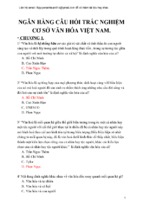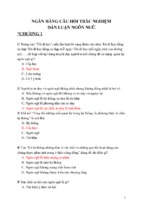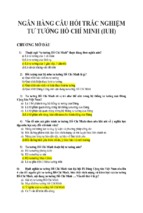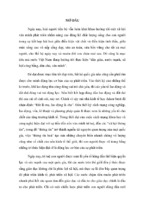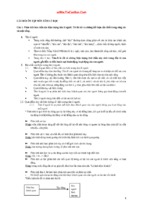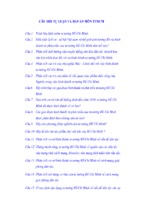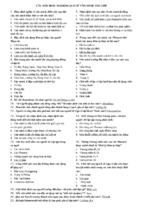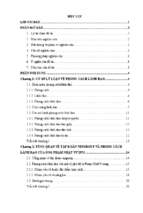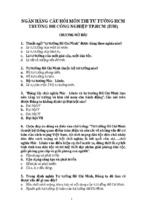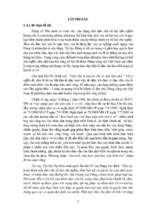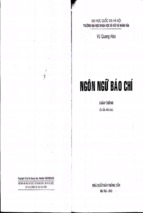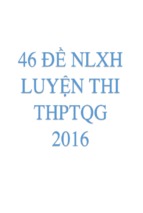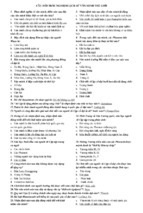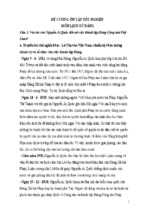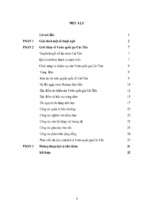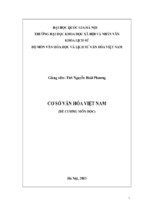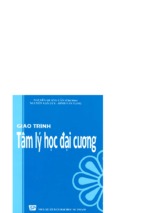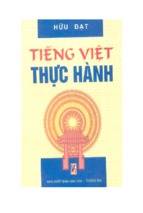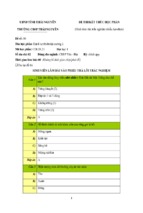MINISTRY OF EDUCATION
AND TRAINING
MINISTRY OF AGRICULTURE
AND RURAL DEVELOPMENT
VIETNAMESE ACADEMY OF FOREST SCIENCES
==================
NGUYEN THI BICH NGOC
STUDY ON FORESTRY CHARACTERISTICS AND
TECHNICAL METHODS OF CULTIVATION OF
Burretiodendron hsienmu Chun et How IN SON LA AND DIEN
BIEN PROVINCES
Specialized: Silviculture
Code: 9.62.02.05
SUMMARY OF THESIS PROGRESSION FORESTRY
Hanoi - 2020
This work has been completed at the Vietnamese Academy of Forest
Sciences
Full name of instructor: Prof.Dr. Vo Dai Hai
TS. Phí Hồng Hải
Chairman:
Reviewer 1:
Reviewer 2:
Reviewer 3:
The thesis is defended in front of the Institute's thesis-judging council
meeting at the Vietnamese Academy of Forest Sciences
At the hour minute day month year 2020
The dissertation can be found at: National Library and Vietnam Library
of Forestry Science
PUBLISHED SCIENTIFIC WORKS
RELATED TO THE THESIS
1. Nguyen Thi Bich Ngoc (2017), Structural characteristics of natural
forest place that Burretiodendron hsienmu Chun et How distribution
in Dien Bien and Son La, Journal of Forestry Science, Vietnamese
Academy of Forest Sciences, number 2, page 39-49.
2. Nguyen Thi Bich Ngoc (2017), Testing the quality of seed
germination Burretiodendron hsienmu Chun et How and the effect of
light on baby seedling growth, Journal of Forestry Science,
Vietnamese Academy of Forest Sciences, number 2, page 11-19.
PREAMBLE
1. The urgency of the subject
Burretiodendron hsienmu Chun et How is a large, valuable, multipurpose, high-value timber species and was included in the Vietnam Red List
2007, classified as EN-endangered, belonging to Group IIA in Decree
06/2019/by the Government and VU subordinates of the IUCN international
red list.
Son La and Dien Bien are two mountainous provinces in the Northwest of
Vietnam. On the topography of limestone mountains, Burretiodendron
hsienmu Chun et How is distributed naturally in large quantities. Facing the
needs of socio-economic development, transportation construction, Son La
Hydroelectricity, resettlement of people and especially illegal fishing, the
number of Burretiodendron hsienmu species has been impaired decline.
However, in Vietnam in general and Son La, Dien Bien in particular, the
study Burretiodendron hsienmu is describing the morphology, distribution
and use, lack of in-depth studies on characteristics forestry as well as on
propagation and planting to provide solutions for recovery and development.
From that fact, “Study on forestry characteristics and technical methods of
cultivation of Burretiodendron hsienmu Chun et How in Son La and Dien
Bien provinces” is necessary, with scientific and practical significance.
2. Objectives of the study
In theory: Identifying scientific bases to contribute to the conservation,
restoration and development of Burretiodendron hsienmu Chun et How in
Son La and Dien Bien provinces.
About practice
- Identified some techniques for propagating Burretiodendron hsienmu
Chun et How from seeds and cuttings.
- Identify planting and enrichment techniques of Burretiodendron
hsienmu Chun et How in Son La and Dien Bien provinces.
3. Research object and location
- Subject of research: Burretiodendron hsienmu Chun et How.
1
- Scope of the study: The thesis only studies in forest areas with
Burretiodendron hsienmu Chun et How, distributed naturally in the Dien
Bien and Son La.
4. Research scope
Regarding the content: The thesis only studies:
(1) The forestry characteristics of the species Burretiodendron hsienmu
(including: Morphological, climatic, site, climatic, altitude, elevation,
stratum, accompanying species characteristics, regeneration characteristics,
composition, composition characteristics high tree structure); (2)
Burretiodendron hsienmu Chun et How propagation techniques from seeds
and cuttings; (3) Planting Burretiodendron hsienmu (including experiments:
Fertilizers; Criteria of seedlings for planting; mixed rate with Chukrasia
tabularis).
Research location: (1) Study on forestry characteristics in Muong Giang
and Chieng Khoang Commune, Quynh Nhai District, Son La; Phong Lai
commune, Thuan Chau district, Son La; Pu Nhung and Toa Tinh commune,
Tuan Giao district, Dien Bien; (2) Seeds and cuttings are taken from natural
forests at the 5 points above. In addition, cuttings were also taken from the 2year-old mother plant was rejuvenated at the nursery of Tay Bac University,
Son La; (3) Propagation is conducted at the Tay Bac University; (4) Trial
models were conducted in Toa Tinh commune, Tuan Giao district, Dien Bien
province and Muong Giang commune, Quynh Nhai district, Son La province.
Research time: (1) Seed propagation studies were monitored until plants
were 12 months old; (2) The cuttings experiment was monitored for 30
weeks/time. (3) Planting experiments were monitored for 4 years; (4)
Material research was conducted from January 2014 to August 2016.
5. Scientific and practical meanings
Scientific significance: Contributing to supplementing information on
forestry characteristics and providing additional scientific arguments on
propagation and planting techniques to serve the conservation and
development of Burretiodendron hsienmu Chun et How.
2
Practical significance: The research results of the thesis have proposed a
number of feasible technical solutions in propagating from seeds, cuttings
and planting techniques of Burretiodendron hsienmu Chun et How in Son La
and Dien Bien provinces.
6. New contributions of the thesis
(i) Supplementing some forestry characteristics of Burretiodendron
hsienmu Chun et How in Son La and Dien Bien provinces.
(ii) Initially identifying techniques for propagation and planting of
Burretiodendron hsienmu Chun et How in Son La and Dien Bien provinces.
7. Dissertation Layout:
The thesis consists of 136 pages with 37 pictures and 36 tables, including:
Introduction (5 pages); Chapter 1: Overview of research issues (25 pages);
Chapter 2: Content, materials and research methods (23 pages); Chapter 3:
Research results and discussion (71 pages); Conclusion, existing and
recommendations (3 pages).
CHAPTER 1. OVERVIEW OF RESEARCH ISSUES
1.1. Research situation in the world
Burretiodendron hsienmu Chun et How in Chinese called Xianmu (Wang
Xianpu, jin Xiaobai, Sun Chengyong (1986). In addition, Burretiodendron
hsienmu Chun et How is also used with many other synonymous scientific
names such as: Burretiodendron tonkinense (Gagnep.) Kosterm .;
Burretiodendron tonkinensis Kosterm; Excentrodendron hsienmu (Chun et
How) Chang et Mian; Pentace tonkinensis A. Chev; ... .;
Li and Wang (1964): In China, Burretiodendron hsienmu appears in the
southwest of Guangxi Autonomous Region, extending west to southwestern
Yunnan province, in the middle of latitude 22°05' to 24°16' North latitude
and 105°00' to 108°06' East longitude, in the subtropical Southern and
Northern tropical regions. Follicles, ripen in June-July, then peel. Wang
Xianpu, Jin Xiaobai, Sun Chengyong (1986) within ten days of collecting
seeds, up to 95% of the seeds can survive, but after storing 20-30 days of
survival, only 60 - 80% left; Most seeds are incapable of germinating after
3
two months of storage. Burretiodendron hsienmu is suitable for limestone
areas, shallow soil.
1.2. Research situation in Vietnam
According to Hoang Kim Ngu (2004), to propagate Burretiodendron
hsienmu Chun et How for afforestation, it is possible to use the propagating
method from naturally regenerated seedlings in the forest to transplant into
pots, put into beds with canopy cover. 0.7-0.8, tending, watering for new
roots, planting under canopy of forest or shade trees from 0.5-0.7.
Nguyen Thi Bich Ngoc (2012) conducted a breeding experiment of
Burretiodendron hsienmu Chun et How by taking advantage of regenerated
seedlings from the forest. Through collection of regenerated trees, the
adjustment of density and distribution network of regenerated trees will be
combined with the research site.
Nguyen Thi Luan and Bui Minh Quang (2006) conducted a tissue culture
experiment of Burretiodendron hsienmu Chun et How through studying the
effect of growth regulators on the ability to shoot and extend shoots. Results
showed that Burretiodendron hsienmu Chun et How appeared new shoots but
slowly, the study time was too short (4 weeks) so it was not enough basis for
the research team to come up with an appropriate formula for propagation.
According to Hoang Kim Ngu (2004), it is possible to cultivate
Burretiodendron hsienmu Chun et How in limestone areas with elevations
below 1,000m, preferably from 500 to 700m above sea level.
1.3. General comment
In general, studies on Burretiodendron hsienmu Chun et How, both
domestically and internationally, are quite few and not systematic, mainly
focusing on describing morphological, classification and usage
characteristics. The propagation of Burretiodendron hsienmu Chun et How
has not really been paid attention, there have been some experiments on
propagation by seedlings from natural forests, by tissue culture but have yet
to give specific instructions due to the time. Research is short and small scale
so reference value is not high. In particular, there are no studies and
4
experimental models on planting and restoring forest of Burretiodendron
hsienmu Chun et How in most localities with species distribution in Vietnam.
Therefore, the study of forestry characteristics and cultivation techniques of
Burretiodendron hsienmu Chun et How is very scientific and practical..
CHAPTER 2. CONTENT AND METHOD OF RESEARCH
2.1. Research content
(1) Study on some forestry characteristics of Burretiodendron hsienmu
Chun et How in Son La and Dien Bien provinces.
(2) Study on breeding techniques of Burretiodendron hsienmu.
(3) Study on planting techniques of Burretiodendron hsienmu
(4) Proposing some measures to preserve, restore and develop
Burretiodendron hsienmu Chun et How in Son La and Dien Bien.
2.2. Research Methods
2.2.1. Inheritance method
Selectively inherit documents on natural, socio-economic conditions,
forest status maps of Son La and Dien Bien; Documents and results related to
propagation, planting of forest trees and indigenous tree species; Studies on
Burretiodendron hsienmu Chun et How have been performed.
2.2.2. Foreign surveys and data processing
(1) Investigation of forestry characteristics:
Conducted at 5 research sites in Son La and Dien Bien:
- Each site established three survey routes in the natural forest areas on the
limestone mountains has a lot of Burretiodendron hsienmu Chun et How, the
length of each line over 1km has 2 sides expanded as the basis for selecting
the typical location of the plot. standard.
- Describe morphological characteristics by randomly observing leaves
and stems of a total of 25 mature trees; 25 regenerated trees; observe
randomly 5 flowers, 5 fruits on each tree; monitor the wrestling of 15 plants;
inherit meteorological data for 10 years.
- Dig 15 soil profiles (3 sections/site). At each soil sampling point from 3
sections, mix well in 2 depth levels: 0-10cm; 10-30cm and analyzed 16
5
indicators at the Soil and Environment Laboratory of the Forest Ecology and
Environment Research Institute.
- Investigate forest structure:
+ High-rise tree: Set up 15 standard plots of 2,500m2 (50m x 50m).
Measuring height soaring tops, diameter 1.3m, forest canopy (by the method
of 100 points);
+ Investigate the ecological relationship between Burretiodendron
hsienmu Chun et How and the accompanying species in the forest stand: Set
up 100 otc 6 trees by the method of Thomasius (1973).
+ Investigation of regeneration: In each otc, 25 plot plots 4m 2 will be
collected to collect information on regenerated trees (D 1.3 <6cm): The citadel;
height of regenerated tree (m), divided into levels: <1m; 1-2m; 2-3m; > 3m;
Quality (good, bad, average); origin (buds, seeds); Calculation of prospective
regenerated plants is those with a height ≥ 1m, average to good quality.
Select 30 trees Burretiodendron hsienmu Chun et How size D1.3 ≥ 20cm,
no pests, no dead ends as the center, set up odb to study regeneration around
the original stump. Establish odb size 1m 2 (1m x 1m) around the parent tree
in four directions of East, West, South, North, 4 cells in the canopy, 4 outer
canopy areas within a radius Dt that tree, 4 outside canopy with radius ≥ 2Dt
that tree. Information collected includes: Number of young seedlings
(seedlings and seedlings) and height division as above.
- Data processing: Calculate the average value of the size; find the
distribution law of N/D1.3, N/H by Weibull function; analyze the structure of
the composition according to the IV% method of Curtis & McIntosh (1951);
Finding the dominant species group by Daniel Marmillod and by Thai Van
Trung (1978); forest status division according to Louschau (1960) researched
and supplemented by Forest Inventory and Planning Institute; class
hierarchical structure classification based on IUFRO classification
(Leibundgut, 1958); The ecological relationship between Burretiodendron
hsienmu Chun et How and accompanying plants, the minimum nutritional
area of Burretiodendron hsienmu matures based on the frequency of
6
occurrence (applying the method of 6 Thomasius trees (1973)) ;
Regeneration: Analysis of density, composition according to percentage of
trees, percentage of number of trees by level (quality, origin, promising
regeneration, regeneration around parent tree).
(2) Nursing techniques:
- Propagation from seeds: Quality testing of grain quality according to
Industry Standard 04-TCN-33-2001.
+ Experiment on the effect of mother tree collecting seeds on the
germination rate, seed germination potential: Each seed lot randomly
selected 100 pure seeds, treated seeds at an initial temperature of 40 oC,
soaked for 12 hours, picked and after every 24 hours of acid wash, monitor
the germination rate, speed and germination potential of the seed lots.
+ Experiment on the effect of the best seed lot temperature in experiment
1, soak seeds in water with 3 initial temperatures (30 0C; 400C and 200C control water). Each temperature is performed with 30 pure seeds, repeated 3
times, soaking time 12 hours, picked and incubated once every 24 hours,
monitoring the germination rate daily.
+ Experimental effect of shade for seedling growth in nursery stage: Four
shading formulas are arranged (0%; 25%; 50%; 75%).
+ Experimental effect of potting medium composition on seedling growth
in nursery stage: Perform with 3 potting medium formula.
- Propagated from cuttings:
+ Experimental effects of plant growth regulators and concentrations: 3
stimulant drugs, 3 concentration levels, 10 seconds dipping time and nondrug control.
+ Experimental effect of concentration and time dipping: From the above
experiment, to determine the best drug, continue to use this drug for testing
with 5 concentration levels and 3 levels of dipping time.
+ Experimental effect of rejuvenated growth stimulant and cuttings
concentration: Conducted with 3 drugs, 9 levels, uniform dipping time of 20
seconds and non-drug control.
7
The experiments uniformly cuttings spring, the cuttings are 100% clean
sand. Experiments on randomized blocks were complete, replicated 3 times,
and 30 cuttings/repetition.
(3) Planting techniques Burretiodendron hsienmu Chun et How:
Conducting planting experiments in Dien Bien and Son La. Monitoring the
growth of 4 years (2014-2018).
- Effect of seedling standards: Implement 3 formulas: seedlings 9 months,
12 months and 15 months of age. Each area is 0.1 ha/replicate, planted under
the canopy of natural forest on limestone mountains with canopy coverage of
0.4-0.5. Planting density of 400 trees/ha (5m x 5m).
- Effect of fertilizer: Apply 4 different formulas: 0.1kg/tree; 0.2kg/tree;
0.3kg/tree and control without fertilizing. The area of each formula is 0.15
ha/iteration. The planting density of Burretiodendron hsienmu 400 trees/ha
(5mx5m). Planted under natural forest canopy on limestone mountains,
canopy cover 0.4-0.5. Use 12 months pregnant seedlings made from seeds.
- Effect of mixed ratio between Burretiodendron hsienmu and Chukrasia
tabularis: Formula 1 (4 rows of Chukrasia tabularis+1 row of
Burretiodendron hsienmu); formula 2 (3 rows Chukrasia tabularis+1 row
Burretiodendron hsienmu); Formula 3 (2 rows Chukrasia tabularis+1 row
Burretiodendron hsienmu); Formula 4 (1 row Chukrasia tabularis+1 row
Burretiodendron hsienmu). The area of each formula is 0.1 ha/replicate.
Planting density: 2,500 trees/ha (2m x 2m).
CHAPTER 3. RESULTS AND DISCUSSION
3.1. Silvicultural characteristics of species Burretiodendron hsienmu
Chun et How in Son La and Dien Bien
3.1.1. Morphological, ecological, rearing and distribution characteristics
3.1.1.1. Morphological characteristics
a) Morphology Burretiodendron hsienmu Chun et How mature:
Results from table 3.1. showing that under the impact of exploitation,
currently Burretiodendron hsienmu Chun et How in Son La, Dien Bien are
mainly left with small to medium sized trees, much smaller than the
8
documents ever worked. father before. During the field investigation, many
trees Burretiodendron hsienmu Chun et How to be cut down, left behind the
stump with a diameter of over 1m, with a stem diameter of nearly 3m.
Table 3.1: Characteristics of mature size of leaf and trunk of
Burretiodendron hsienmu Chun et How mature
Results of field surveys in Son La and Dien Bien
Muong Chieng Phong
Pu
Toa
Giang Khoang Lai Nhung Tinh
DBH (cm)
36.8
26.2
26.2
26.5
38.1
Tree hight (m)
18.8
14.8
20.5
17.2
17.6
Canopy
7.7
6.8
6.7
6.3
7.8
diameter (m)
Height
under
7.7
9.8
13.8
10.4
8.8
branches (m)
Petiole length (Dc) (cm)
Min
4.0
4.0
3.5
4.0
4.0
Max
8.0
8.0
8.0
8.0
8.0
Average
5.9
6.0
5.8
5.8
5.8
Leaf width (RL) (cm)
Min
6.8
6.8
6.8
6.8
6.8
Max
13.2
13.2
13.2
13.2
13.2
Average
9.6
9.3
9.3
9.0
8.9
Leaf length (DL) (cm)
Min
8.5
8.5
8.5
8.5
8.5
Max
14.4
14.4
14.4
14.4
14.4
Average
11.5
11.1
11.1
11.1
11.2
Number of base veins of the leaf
Number of root
3-5
3-5
3-5
3-5
3-5
[1]
[2]
80-90 100
30-35 > 30
3
5
3,5
5
7
10
7
10
10
12
8
12
3
3
([1]: Vietnam Ministry of Science and Technology (2007), Vietnam Red book, Part
II. Plant, Science and Technology Publishing House; [2]: Le Mong Chan, Le Thi
Huyen (2002), Forest plants, Hanoi Agricultural Publishing House.
On the base of the tree, there is usually a big buttress, the floating root
system attaches deep into the rock holes to help the tree stand firmly on the
limestone mountains. Relatively straight, with gray, flaky rinds, in some trees
with large stumps or stems that appear irregularly shaped.
Leaf morphology: The leaves are single-leafed, ovoid shaped, gradually
9
pointed, with protruding nose, tail shaped or almost round, thick, hard,
smooth, smooth, smooth, raw edges, with 3-5 root veins. Axillary armpit
with submerged glands and small tufts of hair. Leaf size results are quite
similar to the descriptions of previously published documents. However, the
difference is that the leaf size in Son La and Dien Bien is variable and the
stem length is much larger, on the tree there are also leaves with 3 and 5
veins at the base.
b) Morphology Burretiodendron hsienmu Chun et How regenerated
Seedlings under 6 months old have leaf shaped ears, soft stems, stem
height ranges from 3.5 - 4.5cm, average leaf width 2.5cm, average leaf length
2.2cm, leaf tips not with a long nose and concave in. Seedlings over 6
months old are not branched, the leaf shape is similar to mature trees but
smaller in size: petioles 3 - 5cm long, leaves 4-6cm wide, 6-8cm long, leaf
tips protruding. Seedlings over 12 months old are basically the smallest leaf
size and size. Trees regenerated under a canopy of a height of 45cm or higher
have the same leaf size as the average size of an adult tree.
3.1.1.2. Material characteristics
Burretiodendron hsienmu is characterized by unisexual flowers, male
flowers grow in leaf axils, bell-shaped radio, at the top of 5 deep lobes,
1.5cm long. Petals 5, 1.3cm long, yellowish white, stamen 25-35, forming 5
bundles at the base, only 1 to 1.3cm long. Inflorescences include 2-3 flowers,
potting sessile. The oval capsule is 3-4cm long, 1-1.5cm in diameter, has 5
edges, the stem is 2cm long. Dried fruits open on their own. Growth of
Burretiodendron hsienmu Chun et How full phases in a year as shown in
Figure 3.11.
A total of 15 trees investigated for planting only 3 fruit trees. The first
year: Fruit will appear more in the outer branches, with enough sunlight, airy.
In the second and third year, the number of flowers and fruits is smaller, the
number of flowers in the previous year is less, the number of flowers is
higher and vice versa. Thus, it can be predicted that the 2-3 year fruitful
cycle will repeat.
10
Period
of
budding,
young leaves
Flower
buds,
blooms
Fruit
formatio
-n
Ripe
shed
peeled
fruit,
fruit,
Germina
tion,
regenera
tion
Seedlings grow fast, mother plants
do not show any difference
1
2
3
4
5
6
7
8
9
10
11
12 Month
Figure 3.11: Phenological of Burretiodendron hsienmu 1 year cycle
3.1.1.3. Distribution characteristics and ecology where Burretiodendron
hsienmu Chun et How is distributed
a) Distribution characteristics of Burretiodendron hsienmu Chun et How
in Son La, Dien Bien
Burretiodendron hsienmu is distributed in limestone areas, with elevations
from 650-890m, the forest status is mainly IIIA1, a few investigating points
belonging to sacred forests, strict protection forests, early forests The source
of the village should be better in quality and forest reserves, belonging to
status IIIA2 (in Phong Lai and Chieng Khoang communes), which are very
far from residential areas with high slope of 29 - 41 0.
b) Cological characteristics
* Regional climate features have Burretiodendron hsienmu Chun et How
11
distributed: Temperatures from 2.1 to 39.1oC, the highest temperature from
35-39.5oC; minimum temperature ranges from 2.1-8.6 oC; average humidity
ranges from 76-82%; The total rainfall is from 1002.0 to 1822.2mm, and
there are two distinct rainy and dry seasons each year.
* Oil characteristics where Burretiodendron hsienmu Chun et How is
distributed: The results show that the forest floor in the study area is
limestone mountains with many exposed rocks. The depth of the soil layer is
from 50-100cm, rocks are exposed from 30-50%, the soil is relatively
porous, reddish yellow, medium meat composition. The pH KCl ranges from
6.19 to 6.98, the soil has a acidic to neutral status; The total humus content
(total organic) is from 3.56 to 10.34%; total protein 0.317 - 0.619%; Photpho
total from 0.46 to 0.96%; Potassium total from 0.03 to 2.01%.
3.1.2. The rules of high tree structure where Burretiodendron hsienmu
Chun et How are distributed
3.1.2.1. The structure of the tall tree formation where Burretiodendron
hsienmu Chun et How is distributed
Results from 4 - 10 species participating in the composition formula, of
which Burretiodendron hsienmu Chun et How had the highest IV%, ranging
from 13.7% - 36.6%. Next are the species of economic value such as:
Chukrasia tabularis, Choerospondias axillaris, Cinnamomuum balansae,
Schima wallichii, Saraca dives, etc.; some light-demanding pioneer species
such as Cratoxylon prunifolium, Sterculia lanceolata, Sapium dicolor, etc.
The dominant species group has a total IV% ranging from 50.4 - 58.1% and
Burretiodendron hsienmu Chun et How is the dominant species. first in all
research stands, followed by species: Chukrasia tabularis, Saraca dives,
Michelia balansae, Schima wallichii, etc. So, Burretiodendron hsienmu Chun
et How always tend to be distributed in large areas, which is very convenient
for species cultivation.
3.1.2.2. Density and canopy structure of natural forest where there are
distributions in Son La and Dien Bien
The density of stands stands from 260 to 480 trees/ha. The density of
12
Burretiodendron hsienmu Chun et How is from 28 to 80 trees/ha. Forest
canopy ranges from 0.39 to 0.62, the average is 0.50.
3.1.2.3. The distribution rules of N/D1.3 and N/Hvn of natural forest
stands with Burretiodendron hsienmu Chun et How distributed
a) Distribution of N/D1.3: 100% of the studied stands follow the Weibull
distribution. The distribution deviation is from 1.0 to 1.8, showing that the
research stands have a completely reduced or left-wing distribution, the
average diameter ranges from 11.1 to 27.6cm, the trees are concentrated at
the size of the tree. small glasses 8-16cm.
b) Distribution of N/Hvn: 100% of studied stands follow the Weibull
distribution. The distribution deviations are from 1.1 to 2.7, showing that the
studied stands have a completely reduced or left-wing distribution, the
average height is low, from 7.3 to 15.9m; mainly concentrated at sizes of
height 6-10m. Some forest stands of higher average height are in Chieng
Khoang commune and Phong Lai commune, the number of trees is much
concentrated at the size of 15-17m.
3.1.2.4. Growth of Burretiodendron hsienmu and the stratum structure
- In Son La: Muong Giang commune, Quynh Nhai district:
Burretiodendron hsienmu has: DBH ranging from 15.6 to 19.2 cm, height
ranges from 9.4 to 11.7m. In the forest, Burretiodendron hsienmu participates
in the middle and upper layers of the forest;
- In Dien Bien: Pu Nhung commune, DBH Burretiodendron hsienmu
averaged from 13.8 to 13.9cm; The average height is from 8.6 to 10.5m.
Burretiodendron hsienmu mainly participates in the middle and upper layers
of the forest canopy. In Toa Commune, Burretiodendron hsienmu is same.
The results show that in the vertical structure of the stratosphere
Burretiodendron hsienmu always appear from regeneration layer to
ecological dominant layer and canopy layer.
3.1.2.5. The ecological relationship of Burretiodendron hsienmu with the
accompanying plants in the forest area with Burretiodendron hsienmu
distribution
13
a) Frequency of occurrence associated with the species Burretiodendron
hsienmu in the wild
The survey has 37 species that appear with the species Burretiodendron
hsienmu, the frequency of occurrence calculated by the survey point ranges
from 2.0-100%; frequency of occurrence is based on the number of
individuals ranging from 0.3 to 22.0%. Very common species (I) include:
Burretiodendron hsienmu and Chukrasia tabularis, of which
Burretiodendron hsienmu appears next to itself having the highest frequency
100% according to the survey point and 22.0% by number of individuals,
Chukrasia tabularis appears next to Burretiodendron hsienmu with the
frequency of 48.0% according to the survey points and 8.0% according to the
number of individuals. Common species group (II) with Burretiodendron
hsienmu include: Saraca dives, Garcinia fagraeoides, Cinnamomuum iners,
Schima wallichii, Canthium dicoccum, Sapium dicolor, Phyllanthus emblica,
Croton cascarrioides, Archidendron clypearia. The remaining groups are
less common (III): Syzygium aromaticum, Bischofia Javanica, etc.
b) Average nutrient area of Burretiodendron hsienmu in natural forest
Nutritional area of mature Burretiodendron hsienmu in nature ranges from
11.49 - 135.57m2. Study of 100 Burretiodendron hsienmu plants with DBH
ranging from 15-50cm yielded an average nutrient area of 41.13m 2. Thus,
when mature trees burrieni density Burretiodendron hsienmu should only
retain is 244 trees/ha..
3.1.3. Characteristics of regenerating natural forests where
Burretiodendron hsienmu is distributed
3.1.3.1. The structure of a tree to regenerate
The number of species involved in the composition formula ranges from 3
to 10 species. In Son La, the dominant species are predominantly the pioneer
species. Burretiodendron hsienmu is also a dominant species in regenerated
tree species such as accounting for (20.9% - Phong Lai), Chieng Khoang
(31.8%). In Dien Bien, regeneration Burretiodendron hsienmu predominates
in Toa Tinh area with the coefficient from 18.0 to 26.2%, besides the number
14
of regenerated pioneer-demanding tree species is also quite plentiful.
3.1.3.2. Structure of regenerated tree density and promising tree density
The density of regenerated trees is from 2,200 - 7,800 trees / ha, most of
which are concentrated in height from 1m - 2m and from 2m - 3m, in which
prospective regenerated trees account for 36.36 - 81.40% of regenerated
trees. born in the forest stand.
3.1.3.4. Regeneration distribution according to quality and origin
The percentage of regenerated trees of good and medium quality is large,
the regeneration is mainly from seeds.
3.1.3.5. Regeneration Around the mother plant
Burretiodendron hsienmu regenerated in the canopy accounting for
26.7%, mainly seedlings or seedlings <1m. In addition to canopy, where the
radius is greater than 1 times the diameter of the canopy, Burretiodendron
hsienmu regenerates 37.5%, 2 times bigger than canopy diameter accounts
for 33.3% and the number of regenerated trees has a height of 1-3m or > 3m
has increased.
3.2. Study on breeding technique of Burretiodendron hsienmu
3.2.1. Burretiodendron hsienmu propagation techniques from seeds
3.2.1.1. Seed quality testing
a) Seed purity: The purity of the 4 lots of seeds is very high, ranging from
82.0 to 92.6%, can use this source of seed to plant seedlings for nursing.
b) Determination of the weight of 1,000 grains: The mass of 1000 seeds
ranges from 198,2 - 209,6g; The degree of difference between batches of
grain is negligible. The number of seeds in 1 kg ranged from 4,771 to 5,047
and an average of 4,940 seeds.
c) Effect of mother plants on germination rate, germination rate and
germination potential of Burretiodendron hsienmu seeds
Research results in Table 3.20. Standard test 2 here was no statistically
different difference in germination rate among harvested mother plants
(plot): n2 = 3.95 < α2(k=(a-1).(b-1)) = 7.81 (statistical), may be mixed for use in
subsequent experiments. From Table 3.20 shows that the germination rate
15
fluctuated 70-81%, average, every 100 good seeds have 75 germination
seeds. Pragmatic value ranges from 57.4 to 75.0%. Seeds begin to crack after
3 days of incubation until the end of the 17th day, no more germinated seeds,
on average after 12.4 to 13.4 days of germination, germination ranges from
38 - 40%.
Table 3.20: Germination rate, speed and germination potential of
Burretiodendron hsienmu seeds
Plot
Germination Germination Pragmatic value
The
(mother
rate
speed
of each seed lot germination
tree)
E%
S (day)
G%
GE(%)
1
81
12.4
75.0
40
2
70
13.4
57.4
39
3
73
13.4
66.3
38
4 (mix)
78
12.6
68.1
40
Average
75.5
12.9
66.7
39.3
3.2.1.2. Effect of temperature on germination rate of seeds
Seed germination rate ranged from 65.56 to 83.33%, the highest in the
treatment formula of 40oC and lowest in the treatment of seeds at initial
temperature of 30oC. Pass the standard test when the square shows n2 = 7.49
> α2(k=(a-1).(b-1)) = 5.99, Different experimental formulas for different
germination rates. Applying standard U of the standard distribution of
comparative standards shows: U = 179.28 > 1.96 thus, the formula of 40 0C
temperature treatment is the formula for the highest germination rate.
3.2.1.3. Effect of shade to the growth of Burretiodendron hsienmu seedlings
in nursery stage
a) Effect of shade level on survival of Burretiodendron hsienmu seedlings
Comparing with the n2 criterion according to 4 age stages, it is shown
that: Light really has a clear influence on the survival rate of the
Burretiodendron hsienmu seedlings in the nursery stage. Comparing the pair
by criteria U found that the 50% shading formula has the highest survival
rate until the tree is 12 months old.
b) Effect of shade to plant growth: Average diameter of stump from 3.3 to
16
4.1mm (12 months of age). At 12 months, growth is the lowest in the
uncovered formula, the highest is in the 50% shading formula. Comparison
with Student's t-standard shows that: Trees grow best height and diameter at
50% shade.
3.2.1.4. nfluence of potting medium composition on seedling growth during
nursery stage
a) Effect of potting mix on seedling survival rate
In the 3 months, the survival rate ranged from 70.8 to 75%, by the time of
the 6 months, the survival rate decreased to 69.2 - 72.5% and remained this
rate until 12 months. Tested by standard n2 It shows that the potting mix
does not have a clear effect on seedling survival rate.
b) Effect of potting mix on growth of diameter and seedling heigh: Results
of analysis of variance show that at all stages of age, different constituents of
potting medium have not had a clear effect on diameter and height growth.
3.2.2. Research results of propagation techniques from cuttings
3.2.2.1. Effect of plant growth regulators and concentrations on cuttings'
ability to form roots from natural forests
After 1 week, the cuttings began to show the phenomenon of leaf drop,
from the 2nd week, they started to bud. After 10 weeks, most living cuttings
formed scar tissue, and after 20 weeks of cuttings began to have small white
roots, the care process lasts until 30 weeks.
a) Effect of plant growth regulators on cuttings' rooting rate
The rooting rate of Burretiodendron hsienmu is low, averaging from 25.56
to 58.89%, of which the highest is IAA 5000ppm and the lowest is NAA
5000ppm. Use the standard n2: Different types of plant growth regulators
affect the rooting rate of cuttings. Using the standard: U=2.09>1.96, the IAA
5000ppm gives the highest rooting rate.
b) Effect of type of plant growth regulators on number of first-class roots,
root length and rooting index of hom Burretiodendron hsienmu: The average
root length ranges from 6.5 - 9.8cm, the average number of root level ranges
from 2.6 - 3.1 pieces/cuttings, the rooting index ranges from 498.42 - 1615,
17
- Xem thêm -

